
Spreading plant on Mt. Ruapehu [C.J. Earle, 2003.03.08].
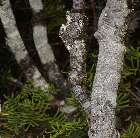
Stems, 3-4 cm diameter, on Mt. Ruapehu [C.J. Earle, 2003.03.08].
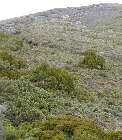
Halocarpus bidwillii on the landscape, distinctive by its yellow-green color [C.J. Earle, 2003.03.08].
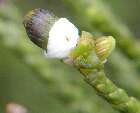
Seed and receptacle on a plant at Taranaki Falls, Mt. Ruapehu [C.J. Earle, 2003.03.08].

Another seed and receptacle on the same plant [C.J. Earle, 2003.03.08].
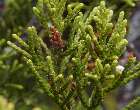
Foliage on the same plant [C.J. Earle, 2003.03.10].
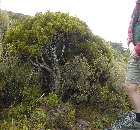
Growing as a small globular shrub on Mt. Ruapehu [C.J. Earle, 2003.03.10].

Halocarpus bidwillii
(Hook. f. ex T. Kirk) C.J. Quinn 1982
Common names
Bog pine, mountain pine (Salmon 1996), tarwood (Dallimore et al. 1967).
Taxonomic notes
Syn: Dacrydium bidwillii Hooker f. ex T. Kirk 1878 (Quinn 1982). Type locality: Nelson. Type: K, Bidwill 130 (Allan 1961).
Possible natural hybrids, H. bidwillii × H. biformis and H. bidwillii × Lepidothamnus laxifolius have been brought into cultivation in New Zealand (Dallimore et al. 1967). "Kirk (For. Fl. 1889, 57) distinguishes two forms: a. erecta, outline conical, flat lvs obscurely ribbed, fruiting branchlets very slender. b. reclinata, prostrate with spreading branches, flat lvs with distinct midrib, fruiting branches rather stout. The status of these and of 'slender forms' of [H. biformis] is not clear. Hybridism between the two spp. is suspected" (Allan 1961).
Description
A spreading or erect, closely branching shrub, or occasionally a small tree up to 3.5 m tall, with a short trunk up to 38 cm in diameter. Sometimes the horizontal branches form roots as they grow, giving rise to a ring of "shrubs" around the parent. Thus develops an extensive mini forest with the appearance of a huge, low-spreading tree or shrub. The parent tree may die, leaving its circlet of outliers intact and flourishing. Bark thin, reddish. Final branchlets 1-1.5 mm in diameter, tetragonous. Has distinct juvenile and mature foliage; the stomata are clearly visible in both. The juvenile leaves are thick and leathery, 5-10 × 1-1.5 mm, rigid, without petioles but with a pronounced midvein below. They spread all round the branchlet. The adult leaves are scale-like, 1-2 mm. long, imbricate, thick, coriaceous, closely appresto the branchlets. Pollen cones are solitary, terminal, c. 3-5 mm long. Epimatium is adnate to the base of a carpidium, coriaceous, covering inverted, with a pendent ovule; integument free, membranous. Seed is 2-3 mm long, subovoid, compressed, with a white to yellowish aril (Allan 1961, Salmon 1996).
Distribution and Ecology
New Zealand, from Cape Colville on the Coromandel Peninsula, to Stewart Island; usually at 600-1,500 m elevation in the north but coming nearer to sea level in the south. It is a hardy plant, growing in both bogs and dry, stony ground, usually in montane to subalpine scrub (Allan 1961, Salmon 1996). Within its range, mean annual temperature is 8.5°C, with an average minimum in the coldest month of -0.8°C, and a mean annual precipitation of 2458 mm (Biffin et al. 2011, Table S5).
Remarkable Specimens
No data as of 2023.02.21.
Ethnobotany
The wood is brittle and of little value (Salmon 1996).
Observations
A scientific reserve at "The Wilderness" near Lake Te Anau has excellent examples growing in stony ground (Salmon 1996). Bog pine is also very common in unforested areas around Mt. Ruapehu, including extensive bogs just east of the town of National Park, and as a dominant shrub in the alpine shrublands. These alpine shrublands are very well displayed around Ketetahi Hut on the Tongariro Crossing, at high elevations on Hauhungatahi, and on walks around Whakapapa on Ruapehu, such as the Taranaki Falls and Silica Rapids tracks. In these settings it often grows with H. biformis.
Remarks
The epithet bidwillii honors John Carne Bidwill (1815-1853), an English-born Australian botanist who became the first director of the Royal Botanic Gardens, Sydney. Bidwill is also remembered in the names Araucaria bidwillii (Araucariaceae, Australia) and Libocedrus bidwillii (Cupressaceae, New Zealand), and is the only botanist to be honored in the names of so many conifers.
Citations
Allan, H. H. 1961. Flora of New Zealand. Volume I, Indigenous Tracheophyta. Wellington: R.E. Owen Government Printer.
See also
Cassie, V. D. 1954. New Zealand conifers. Journal of the Arnold Arboretum 35:268-272. Text available at http://www.botanicus.org/.
Kirk. 1889. Forest Flora of New Zealand.
Molloy 1995.
Webb, C.J. and M.J.A. Simpson. 2001. Seeds of New Zealand Gymnosperms & Dicotyledons. Auckland: Manuka Press.
Gymnosperms of New Zealand.
The New Zealand Plant Conservation Network, accessed 2010.11.22.







